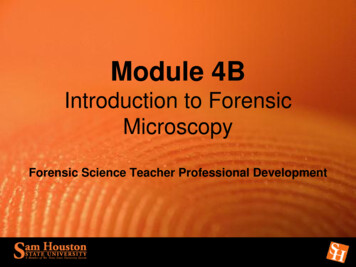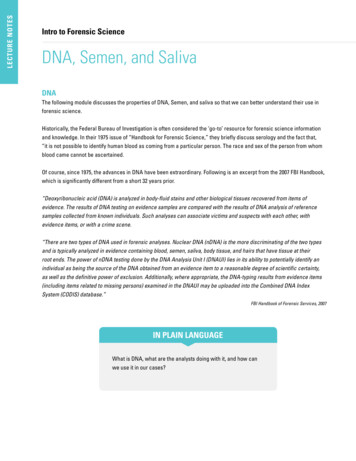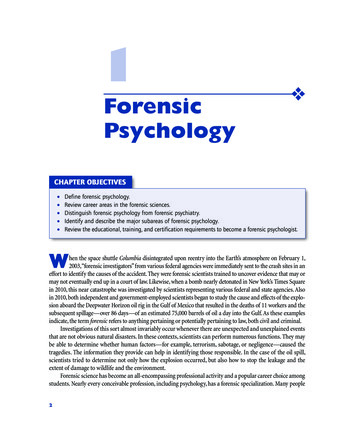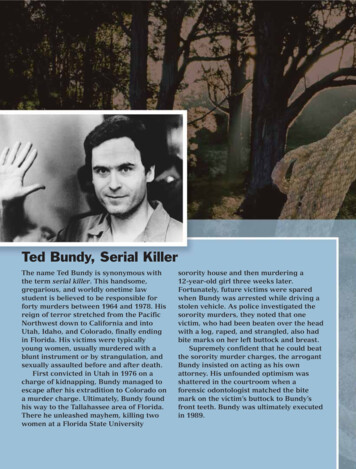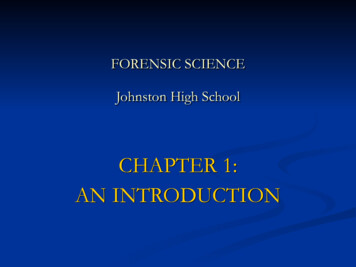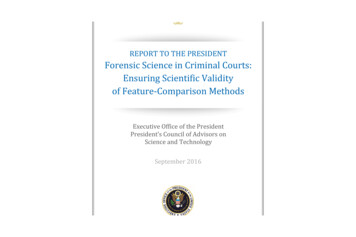
Transcription
REPORT TO THE PRESIDENTForensic Science in Criminal Courts:Ensuring Scientific Validityof Feature-Comparison MethodsExecutive Office of the PresidentPresident’s Council of Advisors onScience and TechnologySeptember 2016
The President’s Council of Advisors onScience and TechnologyCo-ChairsJohn P. HoldrenAssistant to the President forScience and TechnologyDirector, Office of Science and TechnologyPolicyEric S. LanderPresidentBroad Institute of Harvard and MITVice ChairsWilliam PressRaymer Professor in Computer Science andIntegrative BiologyUniversity of Texas at AustinMaxine SavitzHoneywell (ret.)MembersWanda M. AustinPresident and CEOThe Aerospace CorporationChristopher ChybaProfessor, Astrophysical Sciences andInternational AffairsPrinceton UniversityRosina BierbaumProfessor, School of Natural Resources andEnvironment, University of MichiganRoy F. Westin Chair in Natural Economics,School of Public Policy, University ofMarylandS. James Gates, Jr.John S. Toll Professor of PhysicsDirector, Center for String andParticle TheoryUniversity of Maryland, College ParkChristine CasselPlanning DeanKaiser Permanente School of MedicineMark GorenbergManaging MemberZetta Venture PartnersvNophilosophersof science.
Susan L. GrahamPehong Chen Distinguished Professor Emeritain Electrical Engineering and ComputerScienceUniversity of California, BerkeleyEd PenhoetDirectorAlta PartnersProfessor Emeritus, Biochemistry and PublicHealthUniversity of California, BerkeleyMichael McQuadeSenior Vice President for Science andTechnologyUnited Technologies CorporationBarbara SchaalDean of the Faculty of Arts and SciencesMary-Dell Chilton Distinguished Professor ofBiologyWashington University of St. LouisChad MirkinGeorge B. Rathmann Professor ofChemistryDirector, International Institute forNanotechnologyNorthwestern UniversityEric SchmidtExecutive ChairmanAlphabet, Inc.Mario MolinaDistinguished Professor, Chemistry andBiochemistryUniversity of California, San DiegoProfessor, Center for Atmospheric SciencesScripps Institution of OceanographyDaniel SchragSturgis Hooper Professor of GeologyProfessor, Environmental Science andEngineeringDirector, Harvard University Center forEnvironmentHarvard UniversityCraig MundiePresidentMundie AssociatesStaffAshley PredithExecutive DirectorDiana E. PankevichAAAS Science & Technology Policy FellowJennifer L. MichaelProgram Support Specialistvi
PCAST Working GroupWorking Group members participated in the preparation of this report. The full membership of PCASTreviewed and approved it.Working GroupEric S. Lander (Working Group Chair)PresidentBroad Institute of Harvard and MITMichael McQuadeSenior Vice President for Science andTechnologyUnited Technologies CorporationS. James Gates, Jr.John S. Toll Professor of PhysicsDirector, Center for String andParticle TheoryUniversity of Maryland, College ParkWilliam PressRaymer Professor in Computer Science andIntegrative BiologyUniversity of Texas at AustinSusan L. GrahamPehong Chen Distinguished Professor Emeritain Electrical Engineering and ComputerScienceUniversity of California, BerkeleyDaniel SchragSturgis Hooper Professor of GeologyProfessor, Environmental Science andEngineeringDirector, Harvard University Center forEnvironmentHarvard UniversityStaffDiana E. PankevichAAAS Science & Technology Policy FellowKristen ZarrelliAdvisor, Public Policy & Special ProjectsBroad Institute of Harvard and MITWriterTania SimoncelliSenior Advisor to the DirectorBroad Institute of Harvard and MITvii
Senior AdvisorsPCAST consulted with a panel of legal experts to provide guidance on factual matters relating to theinteraction between science and the law. PCAST also sought guidance and input from two statisticians,who have expertise in this domain. Senior advisors were given an opportunity to review early drafts toensure factual accuracy. PCAST expresses its gratitude to those listed here. Their willingness to engagewith PCAST on specific points does not imply endorsement of the views expressed in this report.Responsibility for the opinions, findings, and recommendations in this report and for any errors of factor interpretation rests solely with PCAST.Senior Advisor Co-ChairsThe Honorable Harry T. EdwardsJudgeUnited States Court of AppealsDistrict of Columbia CircuitJennifer L. MnookinDean, David G. Price and Dallas P. PriceProfessor of LawUniversity of California Los Angeles LawSenior AdvisorsThe Honorable James E. BoasbergDistrict JudgeUnited States District CourtDistrict of ColumbiaThe Honorable Pamela HarrisJudgeUnited States Court of AppealsFourth CircuitThe Honorable Andre M. DavisSenior JudgeUnited States Court of AppealsFourth CircuitKaren KafadarCommonwealth Professor and ChairDepartment of StatisticsUniversity of VirginiaDavid L. FaigmanActing Chancellor & DeanUniversity of California Hastings College ofthe LawThe Honorable Alex KozinskiJudgeUnited States Court of AppealsNinth CircuitStephen FienbergMaurice Falk University Professor of Statisticsand Social Science (Emeritus)Carnegie Mellon UniversityThe Honorable Cornelia T.L. PillardJudgeUnited States Court of AppealsDistrict of Columbia Circuitviii
The Honorable Charles FriedBeneficial Professor of LawHarvard Law SchoolHarvard UniversityThe Honorable Jed S. RakoffDistrict JudgeUnited States District CourtSouthern District of New YorkThe Honorable Nancy GertnerSenior Lecturer on LawHarvard Law SchoolHarvard UniversityThe Honorable Patti B. SarisChief JudgeUnited States District CourtDistrict of Massachusettsix
Executive Summary“Forensic science” has been defined as the application of scientific or technical practices to the recognition,collection, analysis, and interpretation of evidence for criminal and civil law or regulatory issues. Developmentsover the past two decades—including the exoneration of defendants who had been wrongfully convicted basedin part on forensic-science evidence, a variety of studies of the scientific underpinnings of the forensicdisciplines, reviews of expert testimony based on forensic findings, and scandals in state crime laboratories—have called increasing attention to the question of the validity and reliability of some important forms offorensic evidence and of testimony based upon them. 1A multi-year, Congressionally-mandated study of this issue released in 2009 by the National Research Council 2(Strengthening Forensic Science in the United States: A Path Forward) was particularly critical of weaknesses inthe scientific underpinnings of a number of the forensic disciplines routinely used in the criminal justice system.That report led to extensive discussion, inside and outside the Federal government, of a path forward, andultimately to the establishment of two groups: the National Commission on Forensic Science hosted by theDepartment of Justice and the Organization for Scientific Area Committees for Forensic Science at the NationalInstitute of Standards and Technology.When President Obama asked the President’s Council of Advisors on Science and Technology (PCAST) in 2015 toconsider whether there are additional steps that could usefully be taken on the scientific side to strengthen theforensic-science disciplines and ensure the validity of forensic evidence used in the Nation’s legal system, PCASTconcluded that there are two important gaps: (1) the need for clarity about the scientific standards for thevalidity and reliability of forensic methods and (2) the need to evaluate specific forensic methods to determinewhether they have been scientifically established to be valid and reliable.This report aims to help close these gaps for the case of forensic “feature-comparison” methods—that is,methods that attempt to determine whether an evidentiary sample (e.g., from a crime scene) is or is notassociated with a potential “source” sample (e.g., from a suspect), based on the presence of similar patterns,impressions, or other features in the sample and the source. Examples of such methods include the analysis ofDNA, hair, latent fingerprints, firearms and spent ammunition, toolmarks and bitemarks, shoeprints and tiretracks, and handwriting.1Citations to literature in support of points made in the Executive Summary are found in the main body of the report.The National Research Council is the study-conducting arm of the National Academies of Science, Engineering, andMedicine.21Main conclusions:two important gaps:(1) the need for clarity aboutthe scientific standards forthe validity and reliability offorensic methodsand(2) the need to evaluatespecific forensic methods todetermine whether theyhave been scientificallyestablished to be valid andreliable.
convictions. Reviews by the National Institute of Justice and others have found that DNA testing during thecourse of investigations has cleared tens of thousands of suspects and that DNA-based re-examination of pastcases has led so far to the exonerations of 342 defendants. Independent reviews of these cases have revealedthat many relied in part on faulty expert testimony from forensic scientists who had told juries incorrectly thatsimilar features in a pair of samples taken from a suspect and from a crime scene (hair, bullets, bitemarks, tire orshoe treads, or other items) implicated defendants in a crime with a high degree of certainty.The questions that DNA analysis had raised about the scientific validity of traditional forensic disciplines andtestimony based on them led, naturally, to increased efforts to test empirically the reliability of the methodsthat those disciplines employed. Relevant studies that followed included: a 2002 FBI re-examination of microscopic hair comparisons the agency’s scientists had performed incriminal cases, in which DNA testing revealed that 11 percent of hair samples found to matchmicroscopically actually came from different individuals; a 2004 National Research Council report, commissioned by the FBI, on bullet-lead evidence, whichfound that there was insufficient research and data to support drawing a definitive connection betweentwo bullets based on compositional similarity of the lead they contain; a 2005 report of an international committee established by the FBI to review the use of latentfingerprint evidence in the case of a terrorist bombing in Spain, in which the committee found that“confirmation bias”—the inclination to confirm a suspicion based on other grounds—contributed to amisidentification and improper detention; and studies reported in 2009 and 2010 on bitemark evidence, which found that current procedures forcomparing bitemarks are unable to reliably exclude or include a suspect as a potential biter.Beyond these kinds of shortfalls with respect to “reliable methods” in forensic feature-comparison disciplines,reviews have found that expert witnesses have often overstated the probative value of their evidence, going farbeyond what the relevant science can justify. Examiners have sometimes testified, for example, that theirconclusions are “100 percent certain;” or have “zero,” “essentially zero,” or “negligible,” error rate. As manyreviews—including the highly regarded 2009 National Research Council study—have noted, however, suchstatements are not scientifically defensible: all laboratory tests and feature-comparison analyses have non-zeroerror rates.Starting in 2012, the Department of Justice (DOJ) and FBI undertook an unprecedented review of testimony inmore than 3,000 criminal cases involving microscopic hair analysis. Their initial results, released in 2015,showed that FBI examiners had provided scientifically invalid testimony in more than 95 percent of cases wherethat testimony was used to inculpate a defendant at trial. In March 2016, the Department of Justice announcedits intention to expand to additional forensic-science methods its review of forensic testimony by the FBILaboratory in closed criminal cases. This review will help assess the extent to which similar testimonialoverstatement has occurred in other forensic disciplines.3!!
The 2009 National Research Council report was the most comprehensive review to date of the forensic sciencesin this country. The report made clear that some types of problems, irregularities, and miscarriages of justicecannot simply be attributed to a handful of rogue analysts or underperforming laboratories, but are systemicand pervasive—the result of factors including a high degree of fragmentation (including disparate and ofteninadequate training and educational requirements, resources, and capacities of laboratories), a lack ofstandardization of the disciplines, insufficient high-quality research and education, and a dearth of peerreviewed studies establishing the scientific basis and validity of many routinely used forensic methods.The 2009 report found that shortcomings in the forensic sciences were especially prevalent among the featurecomparison disciplines, many of which, the report said, lacked well-defined systems for determining error ratesand had not done studies to establish the uniqueness or relative rarity or commonality of the particular marks orfeatures examined. In addition, proficiency testing, where it had been conducted, showed instances of poorperformance by specific examiners. In short, the report concluded that “much forensic evidence—including, forexample, bitemarks and firearm and toolmark identifications—is introduced in criminal trials without anymeaningful scientific validation, determination of error rates, or reliability testing to explain the limits of thediscipline.”The Legal ContextHistorically, forensic science has been used primarily in two phases of the criminal-justice process: (1)investigation, which seeks to identify the likely perpetrator of a crime, and (2) prosecution, which seeks to provethe guilt of a defendant beyond a reasonable doubt. In recent years, forensic science—particularly DNAanalysis—has also come into wide use for challenging past convictions.Importantly, the investigative and prosecutorial phases involve different standards for the use of forensicscience and other investigative tools. In investigations, insights and information may come from both wellestablished science and exploratory approaches. In the prosecution phase, forensic science must satisfy a higherstandard. Specifically, the Federal Rules of Evidence (Rule 702(c,d)) require that expert testimony be based,among other things, on “reliable principles and methods” that have been “reliably applied” to the facts of thecase. And, the Supreme Court has stated that judges must determine “whether the reasoning or methodologyunderlying the testimony is scientifically valid.”This is where legal standards and scientific standards intersect. Judges’ decisions about the admissibility ofscientific evidence rest solely on legal standards; they are exclusively the province of the courts and PCAST doesnot opine on them. But, these decisions require making determinations about scientific validity. It is the properprovince of the scientific community to provide guidance concerning scientific standards for scientific validity,and it is on those scientific standards that PCAST focuses here.We distinguish here between two types of scientific validity: foundational validity and validity as applied.(1) Foundational validity for a forensic-science method requires that it be shown, based on empiricalstudies, to be repeatable, reproducible, and accurate, at levels that have been measured and areappropriate to the intended application. Foundational validity, then, means that a method can, in4repeatable,reproducible,and accurate
principle, be reliable. It is the scientific concept we mean to correspond to the legal requirement, inRule 702(c), of “reliable principles and methods.”(2) Validity as applied means that the method has been reliably applied in practice. It is the scientificconcept we mean to correspond to the legal requirement, in Rule 702(d), that an expert “has reliablyapplied the principles and methods to the facts of the case.”Scientific Criteria for Validity and Reliability of Forensic Feature-Comparison MethodsChapter 4 of the main report provides a detailed description of the scientific criteria for establishing thefoundationally validity and reliability of forensic feature-comparison methods, including both objective andsubjective methods. 3Subjective methods require particularly careful scrutiny because their heavy reliance on human judgment meansthey are especially vulnerable to human error, inconsistency across examiners, and cognitive bias. In theforensic feature-comparison disciplines, cognitive bias includes the phenomena that, in certain settings, humansmay tend naturally to focus on similarities between samples and discount differences and may also beinfluenced by extraneous information and external pressures about a case.The essential points of foundational validity include the following:(1) Foundational validity requires that a method has been subjected to empirical testing by multiple groups,under conditions appropriate to its intended use. The studies must (a) demonstrate that the method isrepeatable and reproducible and (b) provide valid estimates of the method’s accuracy (that is, howoften the method reaches an incorrect conclusion) that indicate the method is appropriate to theintended application.(2) For objective methods, the foundational validity of the method can be established by studyingmeasuring the accuracy, reproducibility, and consistency of each of its individual steps.(3) For subjective feature-comparison methods, because the individual steps are not objectively specified,the method must be evaluated as if it were a “black box” in the examiner’s head. Evaluations of validityand reliability must therefore be based on “black-box studies,” in which many examiners render3Feature-comparison methods may be classified as either objective or subjective. By objective feature-comparisonmethods, we mean methods consisting of procedures that are each defined with enough standardized and quantifiabledetail that they can be performed by either an automated system or human examiners exercising little or no judgment. Bysubjective methods, we mean methods including key procedures that involve significant human judgment—for example,about which features to select within a pattern or how to determine whether the features are sufficiently similar to becalled a probable match.5
decisions about many independent tests (typically, involving “questioned” samples and one or more“known” samples) and the error rates are determined.(4) Without appropriate estimates of accuracy, an examiner’s statement that two samples are similar—oreven indistinguishable—is scientifically meaningless: it has no probative value, and considerablepotential for prejudicial impact.Once a method has been established as foundationally valid based on appropriate empirical studies, claimsabout the method’s accuracy and the probative value of proposed identifications, in order to be valid, must bebased on such empirical studies. Statements claiming or implying greater certainty than demonstrated byempirical evidence are scientifically invalid. Forensic examiners should therefore report findings of a proposedidentification with clarity and restraint, explaining in each case that the fact that two samples satisfy a method’scriteria for a proposed match does not mean that the samples are from the same source. For example, if thefalse positive rate of a method has been found to be 1 in 50, experts should not imply that the method is able toproduce results at a higher accuracy.To meet the scientific criteria for validity as applied, two tests must be met:(1) The forensic examiner must have been shown to be capable of reliably applying the method and mustactually have done so. Demonstrating that an expert is capable of reliably applying the method iscrucial—especially for subjective methods, in which human judgment plays a central role. From ascientific standpoint, the ability to apply a method reliably can be demonstrated only through empiricaltesting that measures how often the expert reaches the correct answer. Determining whether anexaminer has actually reliably applied the method requires that the procedures actually used in thecase, the results obtained, and the laboratory notes be made available for scientific review by others.(2) The practitioner’s assertions about the probative value of proposed identifications must be scientificallyvalid. The expert should report the overall false-positive rate and sensitivity for the method establishedin the studies of foundational validity and should demonstrate that the samples used in the foundationalstudies are relevant to the facts of the case. Where applicable, the expert should report the probativevalue of the observed match based on the specific features observed in the case. And the expert shouldnot make claims or implications that go beyond the empirical evidence and the applications of validstatistical principles to that evidence.We note, finally, that neither experience, nor judgment, nor good professional practices (such as certificationprograms and accreditation programs, standardized protocols, proficiency testing, and codes of ethics) cansubstitute for actual evidence of foundational validity and reliability. The frequency with which a particularpattern or set of features will be observed in different samples, which is an essential element in drawingconclusions, is not a matter of “judgment.” It is an empirical matter for which only empirical evidence isrelevant. Similarly, an expert’s expression of confidence based on personal professional experience orexpressions of consensus among practitioners about the accuracy of their field is no substitute for error ratesestimated from relevant studies. For forensic feature-comparison methods, establishing foundational validitybased on empirical evidence is thus a sine qua non. Nothing can substitute for it.6Expert’s judgment nosubstitute for “empiricalevidence.”“empirical evidence is thusa sine qua non. Nothingcan substitute for it.”
Feature-comparison methods may be classified as either objective or subjective. By objective featurecomparison methods, we mean methods consisting of procedures that are each defined with enoughstandardized and quantifiable detail that they can be performed by either an automated system or humanexaminers exercising little or no judgment. By subjective methods, we mean methods including key proceduresthat involve significant human judgment—for example, about which features to select or how to determinewhether the features are sufficiently similar to be called a proposed identification.Objective methods are, in general, preferable to subjective methods. Analyses that depend on human judgment(rather than a quantitative measure of similarity) are obviously more susceptible to human error, bias, andperformance variability across examiners. 103 In contrast, objective, quantified methods tend to yield greateraccuracy, repeatability and reliability, including reducing variation in results among examiners. Subjectivemethods can evolve into or be replaced by objective methods. 1044.2 Foundational Validity: Requirement for Empirical StudiesFor a metrological method to be scientifically valid and reliable, the procedures that comprise it must be shown,based on empirical studies, to be repeatable, reproducible, and accurate, at levels that have been measured andare appropriate to the intended application. 105,106BOX 2. Definition of key termsBy “repeatable,” we mean that, with known probability, an examiner obtains the same result, whenanalyzing samples from the same sources.By “reproducible,” we mean that, with known probability, different examiners obtain the same result, whenanalyzing the same samples.By “accurate,” we mean that, with known probabilities, an examiner obtains correct results both (1) forsamples from the same source (true positives) and (2) for samples from different sources (true negatives).By “reliability,” we mean repeatability, reproducibility, and accuracy. 107103Dror, I.E. “A hierarchy of expert performance.” Journal of Applied Research in Memory and Cognition, Vol. 5 (2016): 121127.104For example, before the development of objective tests for intoxication, courts had to rely exclusively on the testimonyof police officers and others who in turn relied on behavioral indications of drunkenness and the presence of alcohol on thebreath. The development of objective chemical tests drove a change from subjective to objective standards.105National Physical Laboratory. “A Beginner’s Guide to Measurement.” (2010) available -Measurement.pdf; Pavese, F. “An Introduction to Data ModellingPrinciples in Metrology and Testing.” in Data Modeling for Metrology and Testing in Measurement Science, Pavese, F. andA.B. Forbes (Eds.) Birkhäuser (2009).106Feature-comparison methods that get the wrong answer too often have, by definition, low probative value. As discussedabove, the prejudicial impact will thus likely to outweigh the probative value.107We note that “reliability” also has a narrow meaning within the field of statistics referring to “consistency”—that is, theextent to which a method produces the same result, regardless of whether the result is accurate. This is not the sense inwhich “reliability” is used in this report, or in the law.47Terms of art defined.“Repeatable” and “Reproducible”have slightly different meaningsin the context of controlled trials.
By “scientific validity,” we mean that a method has shown, based on empirical studies, to be reliable withlevels of repeatability, reproducibility, and accuracy that are appropriate to the intended application.By an “empirical study,” we mean test in which a method has been used to analyze a large number ofindependent sets of samples, similar in relevant aspects to those encountered in casework, in order toestimate the method’s repeatability, reproducibility, and accuracy.By a “black-box study,” we mean an empirical study that assesses a subjective method by having examinersanalyze samples and render opinions about the origin or similarity of samples.The method need not be perfect, but it is clearly essential that its accuracy has been measured based onappropriate empirical testing and is high enough to be appropriate to the application. Without an appropriateestimate of its accuracy, a metrological method is useless—because one has no idea how to interpret its results.The importance of knowing a method’s accuracy was emphasized by the 2009 NRC report on forensic scienceand by a 2010 NRC report on biometric technologies. 108To meet the scientific criteria of foundational validity, two key elements are required:(1) a reproducible and consistent procedure for (a) identifying features within evidence samples; (b)comparing the features in two samples; and (c) determining, based on the similarity between thefeatures in two samples, whether the samples should be declared to be a proposed identification(“matching rule”).(2) empirical measurements, from multiple independent studies, of (a) the method’s false positive rate—that is, the probability it declares a proposed identification between samples that actually come fromdifferent sources and (b) the method’s sensitivity—that is, probability that it declares a proposedidentification between samples that actually come from the same source.We discuss these elements in turn.Reproducible and Consistent ProceduresFor a method to be objective, each of the three steps (feature identification, feature comparison, and matchingrule) should be precisely defined, reproducible and consistent. Forensic examiners should identify relevantfeatures in the same way and obtain the same result. They should compare features in the same quantitativemanner. To declare a proposed identification, they should calculate whether the features in an evidentiarysample and the features in a sample from a suspected source lie within a pre-specified measurement tolerance108“Biometric recognition is an inherently probabilistic endeavor Consequently, even when the technology and the systemit is embedded in are behaving as designed, there is inevitable uncertainty and risk of error.” National Research Council,“Biometric Recognition: Challenges and Opportunities.” The National Academies Press. Washington DC. (2010): viii-ix.48
As matters currently stand, a certainty statement regarding toolmark pattern matching has the sameprobative value as the vision of a psychic: it reflects nothing more than the individual’s foundationless faithin what he believes to be true. This is not evidence on which we can in good conscience rely, particularly incriminal cases, where we demand proof—real proof—beyond a reasonable doubt, precisely because thestakes are so high. 126In science, assertions that a metrological method is more accurate than has been empirically demonstrated arerightly regarded as mere speculation, not valid conclusions that merit credence.4.4 Neither Experience nor Professional Practices Can Substitute for FoundationalValidityIn some settings, an expert may be scientifically capable of rendering judgments based primarily on his or her“experience” and “judgment.” Based on experience, a surgeon might be scientifically qualified to offer ajudgment about whether another doctor acted appropriately in the operating theater or a psychiatrist might bescientifically qualified to offer a judgment about whether a defendant is mentally competent to assist in his orher defense.By contrast, “experience” or “judgment” cannot be used to establish the scientific validity and reliability of ametrological method, such as a forensic feature-comparison method. The frequency with which a particularpattern or set of features will be observed in different samples, which is an essential element in drawingconclusions, is not
forensic-science disciplines and ensure the validity of forensic evidence used in the Nation’s legal system, PCAST concluded that there are two important gaps: (1) the need for clarity about the scientific standards for the validity and reliability of forensic methods and (2) the need to evaluat




